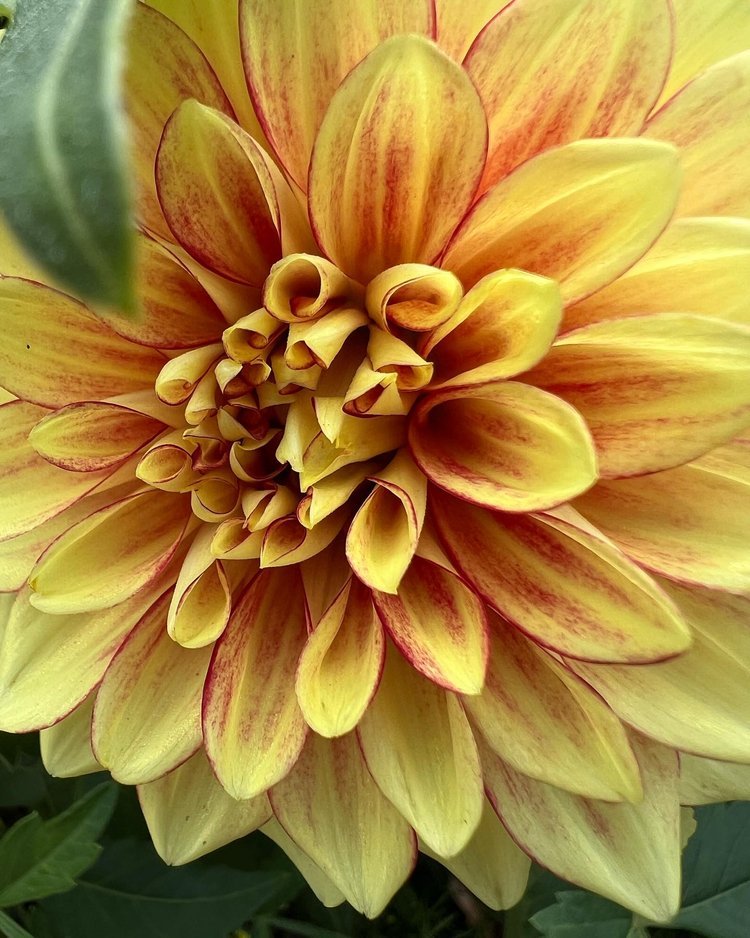Dahlia spp.
Photo of Lake Ontario Variety
By Ilana Sobo
Inn at Shelburne Farms, Vermont
Dahlia spp.
Dahlias are a dazzling celebration of nature’s artistry, renowned for their kaleidoscope of colors, intricate forms, and remarkable diversity. Native to the highlands of Mexico and Central America, dahlias (Dahlia spp.) belong to the Asteraceae family and were cherished by the Aztecs, who cultivated them for their edible tubers, medicinal properties, and as symbols of strength and elegance. Spanish explorers brought dahlias to Europe in the 16th century, where their popularity exploded, particularly during the Victorian era. Today, dahlias are adored worldwide, with over 42 recognized species and thousands of cultivars ranging from petite pom-poms to towering dinnerplate-sized blooms.
One of the most fascinating aspects of dahlias is their extraordinary variety. These flowers come in nearly every color except true blue, with shades that include fiery oranges, soft pastels, and striking bicolors. Their shapes are equally diverse, from the compact, ball-like blooms of pom-pom dahlias to the spiky, starburst forms of cactus dahlias and the immense, dramatic flowers of dinnerplate varieties. Some popular types include ‘Cafe au Lait’, known for its creamy blush petals; ‘Bishop of Llandaff’, famous for its deep red blooms and dark foliage; and ‘Kelvin Floodlight’, a luminous yellow dinnerplate dahlia.
Beyond their sheer beauty, dahlias are cherished for their ability to attract pollinators like bees, butterflies, and even hummingbirds, contributing to a vibrant garden ecosystem. They thrive in sunny, well-drained locations and prefer fertile soil enriched with organic matter. Dahlias are typically grown from tubers, which are planted in spring after the last frost. Regular watering, staking taller varieties, and deadheading faded blooms will reward you with continuous flowering from midsummer through the first frost. In colder climates, the tubers can be dug up and stored indoors over winter, ensuring their return for another season of splendor.
Symbolically, dahlias embody qualities such as strength, creativity, and commitment, often associated with enduring bonds and unyielding grace. They have a timeless appeal, gracing everything from lush wedding bouquets to show-stopping garden borders. Whether planted en masse for dramatic impact, used as a centerpiece in a cutting garden, or grown in pots on a sunny patio, dahlias add an unparalleled sense of joy and celebration to any space.
Fun Dahlia Facts
The dahlia is Mexico's national flower, and October 4th is celebrated as National Dahlia Day in the country.
In the language of flowers, dahlias symbolize elegance, inner strength, and change.
There is an annual dahlia competition in the UK, where growers showcase their most stunning specimens.
Growing Tips for Dahlias
Location: Plant dahlias in full sun, at least 6–8 hours daily.
Soil: Ensure well-draining, fertile soil with a pH of 6.5–7.0.
Planting: Plant tubers 4–6 inches deep, with the “eye” or sprout facing upwards. Space plants 12–24 inches apart, depending on the variety.
Maintenance: Water deeply but allow the soil to dry slightly between waterings. Support taller varieties with stakes or cages.
Frost Protection: In zones where winter temperatures drop below freezing, dig up tubers and store them in a cool, dry place until spring.
References
Hansen, Fiona, and Jill Perry. Dahlias: Beautiful Varieties for Home and Garden. London: Pavilion Books, 2018.
Horticultural Society of London. The Dahlia: Its History and Cultivation. London: Methuen & Co., 1910.
National Garden Bureau. "Dahlia Fact Sheet." https://ngb.org/
Phillips, Roger, and Martyn Rix. Perennials: Volume 2, Late Perennials. London: Macmillan, 2001.
University of Minnesota Extension. "Dahlias for the Home Garden." https://extension.umn.edu/

